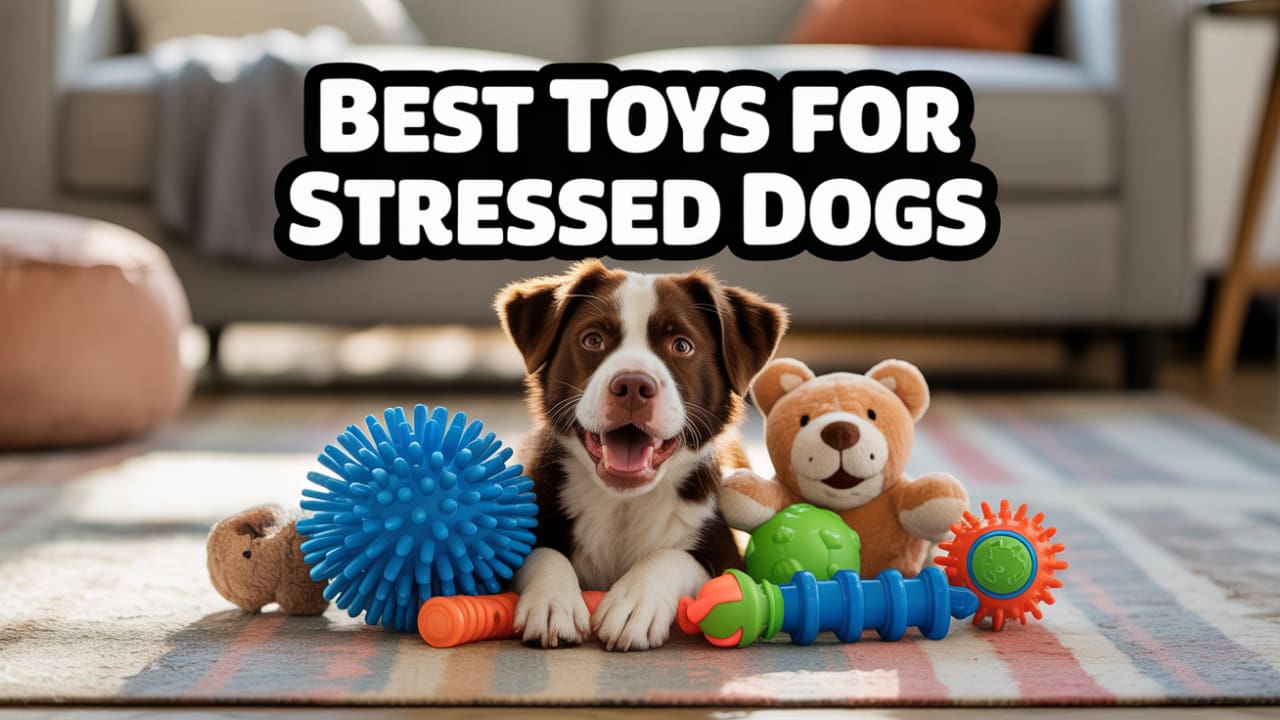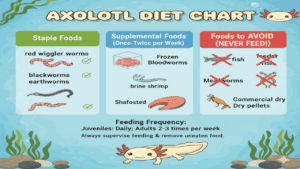Dog Toys for Anxious Dogs (2025 Buyer’s Guide): Expert Picks, Safety Tips, Price Insights, and Mistakes to Avoid
Your dog’s anxious behaviors… the constant chewing, pacing, or whining when you leave. They aren’t just frustrating. They’re heartbreaking.
Finding the right dog toy for anxiety relief can make all the difference. But not all toys offer the comfort or safety your dog truly needs.
The best dog toys for anxious dogs aren’t always the cheapest or the cutest. They’re the ones designed to match your dog’s stress triggers, chewing style, and play preferences.
For example, some plush toys with heartbeat simulators can reduce nighttime anxiety, while durable puzzle toys may lower cortisol levels during separation stress.
But there’s a catch. Many pet parents mistakenly buy toys that are too flimsy or unsafe for crates. And this usually leads to wasted money or worse, a choking risk.
So, do you want to avoid those mistakes and make a confident purchase? Keep reading. Because in the next few minutes, you’ll learn exactly what features matter most, which products are worth the price, and how to spot red flags before you buy.
What toys are good for anxious dogs?
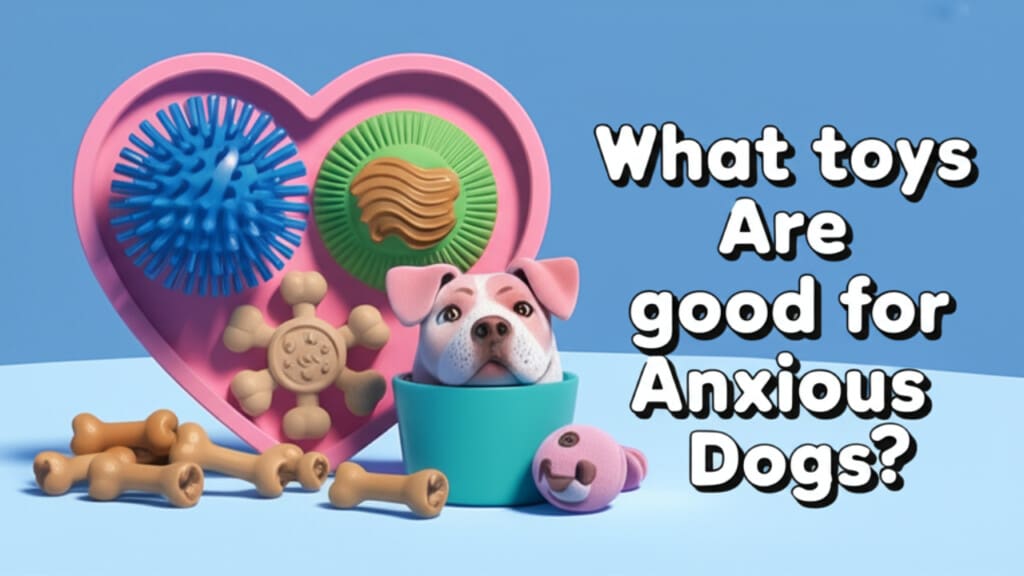
When dogs experience anxiety, whether from separation, loud noises, or changes in routine, toys can offer more than just distraction-they can provide comfort and behavioral support. But not all toys are equally effective when it comes to easing anxiety. The right choice can reduce stress, encourage calm behavior, and even prevent destructive habits like chewing furniture or excessive barking. Let’s break it down. The best toys for anxious dogs typically fall into one of three categories: interactive toys, plush comfort toys, and chewable calming aids.
Interactive toys like treat-dispensing puzzles or slow feeders engage your dog’s brain and keep them focused on a task, which is grounding during stressful moments. These are especially helpful for dogs with separation anxiety, as they ease the emotional impact of being left alone. Plush toys, especially those with a heartbeat simulator or heat pack, mimic the feeling of another presence-great for crate training or bedtime. Meanwhile, tough chew toys with calming scents like lavender or chamomile help relieve stress through chewing, which naturally soothes dogs.
That said, many pet parents assume any toy labeled “calming” will work. In reality, choosing toys without considering your dog’s triggers, chewing strength, or size can make anxiety worse. A small plush toy could become a choking hazard, and a puzzle that’s too hard might frustrate your dog even more. According to experts, it’s important to match a toy’s function and design with your dog’s behavior and needs.
Also, just having the right toy isn’t enough-it matters how you use them. Veterinary behaviorist Dr. Kelly Ballantyne recommends rotating toys regularly to prevent boredom. Research shows 67% of anxious dogs lose interest in calming toys within 2–3 weeks if the same ones are used every day. When dogs get too used to a toy, it becomes less effective. To keep things fresh, try a weekly rotation schedule: frozen Kongs on Mondays, snuffle mats on Tuesdays, heartbeat plush toys on Wednesdays, puzzle feeders on Thursdays, lick mats on Fridays, and a mix of favorites over the weekend. Swap out different textures like rubber, fabric, and nylon, and store toys away for 1–2 weeks before reusing to make them feel “new” again. Most importantly, don’t take toys away during stressful moments-it can create negative associations. This simple routine helps toys stay interesting and supports your dog’s emotional well-being.
And how much should you spend? Budget-friendly toys under $20 can offer short-term comfort, but high-quality interactive toys with proven calming features often range from $10 to $60, especially if they’re vet-recommended or come with washable parts for hygiene. Looking for a quick win? Start with a heartbeat plush toy or a basic treat-dispensing ball, and then introduce more advanced options as your dog adapts. You’ll help soothe their nerves and support healthier habits over time.
Want to avoid the most common mistakes buyers make? Keep reading and you’ll find out soon.
2025 Anxiety Tech: Smart Toys & AI Integration
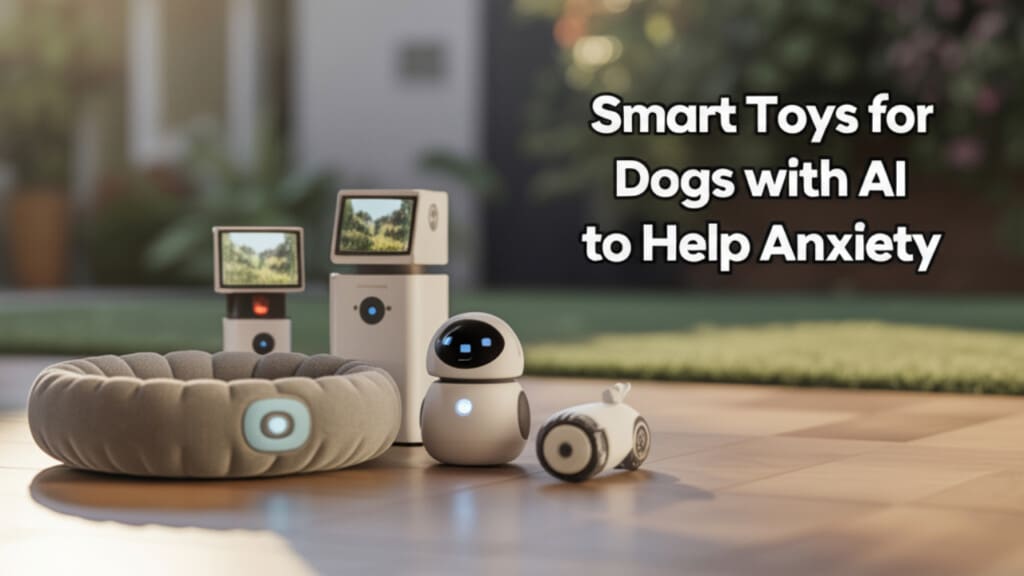
The pet technology landscape has evolved dramatically in 2025, with smart toys now incorporating artificial intelligence and real-time behavioral monitoring. Wearable calming tech has emerged as a game-changer, with devices like the Traini Smart Dog Collar using AI to identify over 10 different emotional states in dogs, including anxiety, excitement, and distress.
These collars analyze barking patterns, heart rate, and body movement to provide comprehensive emotional profiles.
AI-powered toys are adapting to stress cues in real-time. Furbo’s enhanced bark detection system can now differentiate between regular barking, crying, and severe howling – crucial distinctions for anxiety management.
The system’s activity alerts have advanced to detect specific behaviors like excessive pacing or destructive chewing, automatically triggering treat dispensing when anxiety is detected.
Subscription-based replenishable calming inserts are gaining traction, with companies offering monthly deliveries of scent-based anxiety relief components. The smart interactive pet toy market, valued at $1.5 billion in 2024, is projected to reach $3.8 billion by 2033 at a 10.5% CAGR
How do anxiety relief toys help with dog behavior and stress?
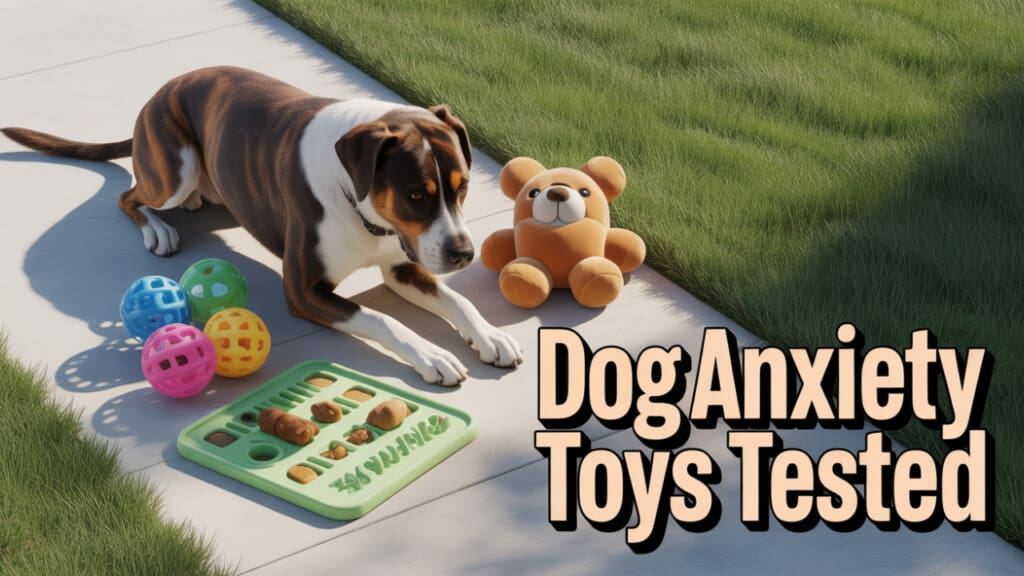
If you’ve ever seen your dog pacing, whining, or destroying furniture while you’re away, you’re not alone. Anxiety in dogs is more common than most owners realize. When left unaddressed, it could lead to long-term behavioral issues.
That’s where anxiety relief toys come in, offering more than just amusement. These tools are designed to actively regulate stress, redirect nervous energy, and support healthier emotional patterns.
So, how exactly do they work? Anxiety relief toys typically engage a dog’s instinctual behaviors… chewing, sniffing, problem-solving, or comfort-seeking.
For example, soothing plush toys mimic companionship, helping dogs who struggle with loneliness or nighttime fear.
Others, like puzzle feeders or treat-dispensing balls, keep the brain engaged, which may lower cortisol levels-the hormone responsible for stress. Dogs that are mentally stimulated are less likely to exhibit destructive behaviors like excessive barking or chewing.
That said, not every toy is therapeutic by default. A basic tennis ball or squeaky toy might provide distraction, but not targeted relief.
Veterinary behaviorists say that some of the most effective calming toys are multi-sensory. This means a combination of smell (e.g., lavender inserts), motion (e.g., heartbeat simulators), and interaction to soothe the nervous system.
You should look for toys that are specifically labeled for anxiety or designed with behavior science in mind.
Wondering about cost? While simple chew-based calming toys start around $15-$20, more advanced models with electronic features or weighted fillings often run $35-$60.
These may seem like a bigger investment. But for dogs with chronic anxiety, the long-term benefits often outweigh the upfront price.
So, the bottom line is: When chosen wisely, anxiety toys can transform your dog’s stress into focus, play, and calm.
Keep reading to learn what features truly matter when choosing the right one.
What features should you look for in calming dog toys?
Choosing a calming toy for your anxious dog isn’t just about grabbing the cutest plush from the pet aisle. To actually reduce stress and support emotional balance, the toy must serve a purpose beyond play.
That’s where smart design and behavioral science come into play, literally. Let’s dig into the must-have features.
First and foremost, texture and material matter. Calming dog toys should be soft enough to provide comfort (especially for cuddling or crating) but durable enough to withstand chewing.
Look for non-toxic, BPA-free rubber, reinforced fabric, or plush blends labeled for aggressive or anxious chewers. Bonus points if they’re machine washable.
Next, interactive or sensory elements are key. Many of the best dog toys for anxious dogs include added features like heartbeat simulators, scent inserts, or treat-dispensing compartments.
Veterinary behaviorists think that toys that stimulate multiple senses (touch, taste, sound, and smell) are more effective at grounding stressed dogs. For example, toys infused with lavender or chamomile may help relax your pet naturally.
Then, there’s size and noise tolerance. A toy that’s too small may pose a choking hazard, while one that squeaks loudly might actually worsen anxiety in noise-sensitive dogs. So always match the toy’s scale and stimulation level to your dog’s temperament.
From a pricing standpoint, feature-rich calming toys range from $20-$60, depending on the complexity and brand. While basic chewable options may suffice for light anxiety, dogs with severe stress often need layered features to truly see results.
So, what does this mean for you? Focus on quality over novelty. Choose toys backed by behavioral insight, not just cute design.
Up next! Let’s talk safety and when it’s okay to leave your dog alone with these toys.
Are all anxiety toys safe for crate use or unsupervised play?
If you’re crating your dog or leaving them alone for extended periods, a common instinct is to toss in a toy to help them self-soothe. But not every toy is made for unsupervised use.
In fact, some can pose hidden risks that many pet owners don’t realize until it’s too late.
Here’s the truth. Not all anxiety toys are crate-safe. Soft plush toys, for example, may be comforting but are often filled with stuffing or squeakers that can become choking hazards if chewed through.
The same goes for toys with detachable parts, poorly stitched seams, or any features not rated for aggressive chewers. Even treat-dispensing toys can become problematic if your dog is prone to frantic chewing or swallowing pieces whole.
What does this mean for you? Choose crate-safe toys specifically labeled for unsupervised play. Look for products described as “indestructible,” “crate-approved,” or “veterinarian-recommended for solo use.”
Experts say that the safest calming toys for anxious dogs are typically solid rubber chew toys, non-toxic nylon bones, or textured silicone options without any seams or stuffing.
Some brands even offer toys designed to be frozen, adding both durability and a cooling, calming effect.
Let’s not forget the cost side of the equation. Safe, high-quality anxiety toys for crate use often start around $25-$40. But the peace of mind they bring is well worth the investment.
Cheaper options might save money up front. But if they lead to vet visits or emergencies, the cost skyrockets.
So, before you close that crate door, pause and ask yourself this question. Would I trust this toy to babysit my dog? If the answer isn’t a solid yes, it’s time to reconsider your pick.
Now, let’s keep reading to explore what price points get you the best return on comfort and safety.
How much should you spend on the best dog toys for anxious dogs?
Buying a calming dog toy isn’t just about keeping your pet busy. It’s an investment in their emotional well-being.
But here’s the big question. How much should you actually spend to get results?
Let’s break it down. Budget-friendly calming toys usually start around $10-$20. And they can be a decent introduction if your dog has mild anxiety.
These include basic rubber chew toys, simple plush items, or low-tech treat dispensers. While affordable, they often lack the behavioral science or sensory features needed for long-term relief.
For dogs with moderate to severe anxiety, experts recommend stepping into the $25-$60 range, where you’ll find interactive puzzle toys, heartbeat plush toys, and even self-soothing options with scent inserts or heat packs.
Veterinary behaviorists say that the best dog toys for anxious dogs are those that offer multi-sensory engagement, not just distraction.
So, you should look for toys with repetitive motion, oral stimulation, or built-in calming features. These aren’t just gimmicks. Many are backed by studies showing measurable reductions in stress behaviors like pacing, whining, or destructive chewing.
Now, one of the most common mistakes buyers make is choosing price over purpose. A $12 squeaky plush might look cute. But if it tears within a day or makes anxiety worse with loud noise, it’s money wasted.
On the flip side, spending $40 on a well-reviewed heartbeat plush or scent-soaked chew can yield weeks or even months of behavioral improvement.
So, what’s the sweet spot? For serious anxiety relief, plan to spend between $30 and $50 for a toy that’s safe, durable, and designed with calming outcomes in mind.
Let’s keep reading to avoid buyer pitfalls that many pet parents overlook.
Common mistakes to avoid when buying toys for dogs with separation anxiety
Buying a toy to calm your dog’s separation anxiety might feel straightforward. That is, until you realize not all toys are made with behavioral relief in mind.
Many pet owners waste money on products that either don’t help or, worse, make things worse. Want to avoid the most common pitfalls? Let’s take a closer look.
One major mistake is choosing toys based on appearance instead of functionality. That cute plush may look comforting. But if it lacks reinforced seams or chew-safe features, it could pose a safety risk or fall apart within hours.
Many vets say that dogs with separation anxiety often channel their nervous energy into intense chewing or shredding, so toys need to be built for durability, not just aesthetics.
Another misstep? Ignoring your dog’s anxiety triggers. Some dogs are noise-sensitive, so toys that squeak or rattle can actually heighten stress rather than reduce it.
Instead, you should opt for silent calming toys, especially those infused with soothing scents or those that simulate human presence, like heartbeat plush companions.
Now, a good number of you may fail to introduce the toy properly. Tossing a new toy into the crate and leaving can often confuse or overwhelm your dog.
Experts recommend supervised introduction, allowing your dog to form a positive association with the toy before using it during solo time.
And while budget options can be tempting, ultra-cheap toys under $10 often cut corners on materials or design.
For dogs with clinical-grade anxiety, investing in a $30-$50 anti-anxiety dog toy with proven features, like treat-dispensing functions or self-soothing surfaces, can mean the difference between temporary distraction and long-term comfort.
Keep reading to find out where to shop (and what to skip) when it comes to purchasing dog toys for anxious dogs.
Where to buy trusted dog toys for anxiety (and what to avoid)
So we know that not all dog toys are created equal. And when your dog struggles with anxiety, the quality and source of the toy matters just as much as the design.
With thousands of calming toys on the market, how do you separate the trusted brands from the forgettable fads?
Start with reputable retailers that specialize in pet wellness. Top-tier online stores like Chewy, Petco, and Amazon’s Verified Pet section often feature well-reviewed dog toys for anxious dogs with clear labeling for anxiety support.
These platforms also give you access to customer ratings, size guides, and safety certifications, which are crucial when buying toys for dogs with separation anxiety or chronic stress.
If you’re shopping in-store, specialty pet boutiques often carry veterinarian-recommended or behaviorist-endorsed toys that you might not find in big-box chains.
Now, this is equally important. What to avoid? You should be wary of generic listings from unbranded third-party sellers, especially on online marketplaces.
Toys that lack material transparency or come with vague product descriptions often fail safety standards. Common red flags include toys with no reviews, excessive use of buzzwords like “calming” without clinical support, or products priced significantly below market averages (e.g., $5 “miracle toys” claiming to cure anxiety overnight).
We’d say that it’s worth spending $10-$60 on trusted anti-anxiety dog toys made from non-toxic, chew-resistant materials and backed by return guarantees. Remember, a poorly made toy can quickly become a choking hazard or a waste of money.
Looking for peace of mind? Stick with brands that disclose their materials, testing processes, and use-case recommendations. Better yet, buy from platforms that offer real-time Q&As with pet experts or customer support.
Next up. Let’s answer the most common buyer questions pet parents have before they hit “Add to Cart.”
Frequently Asked Questions About Dog Toys for Anxious Dogs
When you’re trying to find the best dog toys for anxious dogs, it’s normal to have questions. This is especially true if this is your first time shopping for a calming or therapeutic product.
Whether you’re navigating choices online or comparing options in-store, these are the questions most pet owners ask before hitting “buy.” Let’s answer them one by one:
1. How to quickly calm an anxious dog?
Create a calm space, reduce external stimuli, and offer a calming dog toy, such as a heartbeat plush or a treat-dispensing chew,to redirect nervous energy. Light music and gentle petting may help reinforce the sense of safety.
2. Do dog anxiety toys work?
Yes, especially when they’re selected based on the dog’s specific stress triggers. Interactive, soothing, or scent-based toys are often effective at reducing anxiety-related behaviors.
3. What can I give an extremely anxious dog?
In addition to toys, consult your vet about calming supplements, pheromone sprays, or behavioral therapy. Toys alone may not be enough for dogs with severe anxiety.
4. What’s the best dog toy for separation anxiety?
Look for plush toys with heartbeat simulators or treat puzzles that keep your dog engaged when alone. These offer both comfort and distraction.
5. Are calming dog toys safe to leave in the crate?
Only if they’re specifically labeled crate-safe. Avoid toys with stuffing, squeakers, or detachable parts. Opt for solid rubber or reinforced fabric toys made for unsupervised use.
6. Is it better to buy calming toys in-store or online?
Online retailers like Chewy or Amazon offer more variety, verified reviews, and better return policies. Just avoid third-party sellers with vague listings.
7. Do dogs outgrow the need for anxiety toys?
Some dogs grow out of anxiety, especially with training. But many continue to benefit from calming toys throughout their lives.
8. Can a chew toy help with travel anxiety in dogs?
Yes, especially if it’s a familiar scent or flavor. Chew toys offer oral comfort and mental focus during stressful travel.
9. How do I know if a toy is helping my anxious dog?
You’ll notice fewer signs of stress, like pacing, whining, or chewing furniture. A relaxed posture or choosing the toy during downtime is a good indicator.
10. What’s the difference between a regular dog toy and an anxiety toy?
Anxiety toys are designed to soothe, comfort, or engage the brain. They often have special features like heartbeat pulses, scent infusions, or self-soothing textures that standard toys don’t include.
Still unsure which one is right for your pup? Keep exploring the vetted options we’ve curated for every budget, size, and anxiety level.
What’s the smartest way to choose dog toys for anxious dogs with confidence?
The answer comes down to understanding your dog’s specific anxiety triggers and matching them with the right toy features, whether that’s a heartbeat plush for comfort, a puzzle feeder for mental focus, or a crate-safe chew designed for unsupervised use.
You now know what to avoid (like toys with loose parts or cheap materials), how much to spend for real quality (typically $10-$60), and which expert-backed features truly calm dogs in distress.
Here’s what that means. You’re no longer guessing. You’re equipped to shop smarter and soothe your pup with intention.
Ready to find the toy your anxious dog will actually use and love? Start comparing top-rated options designed for relief, not just play.
Is there a toy that’s helped with your dog’s anxiety? Share it in the comments. Your tip might help another pup feel safe too!

